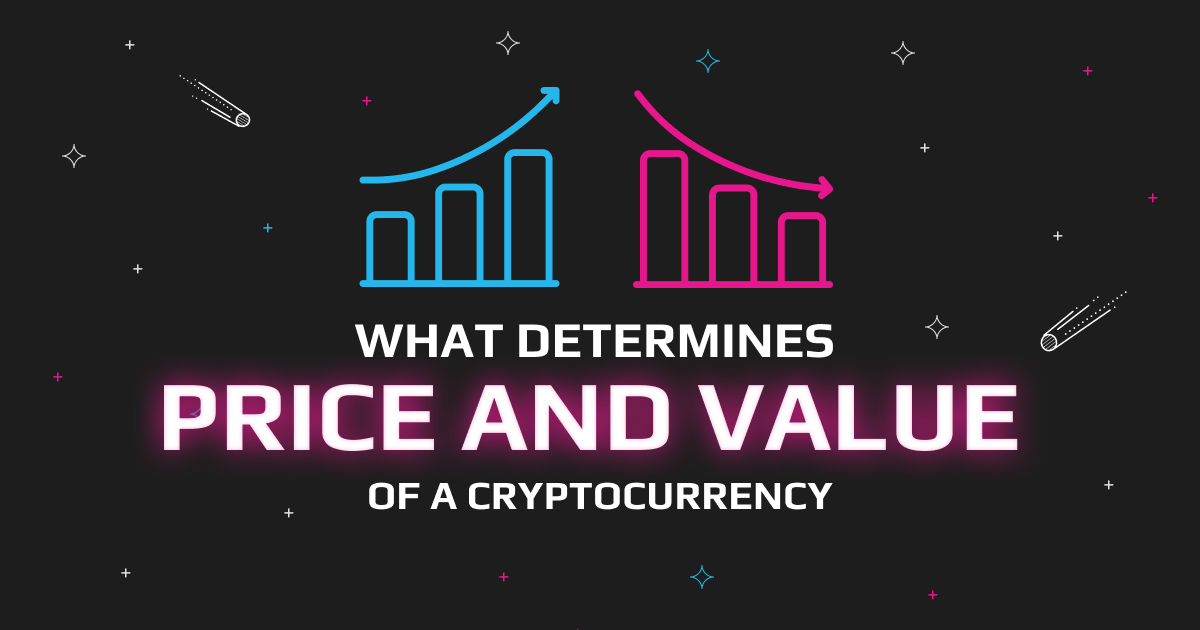Cryptocurrencies are some of the most volatile yet profitable assets in today’s world. Prices can go all the way up, giving investors and traders large returns on investment (ROI) margins.
But they can also go down, causing millions of users to lose billions and even trillions of dollars of funds within a few hours.
So what influences the value of cryptocurrencies like Bitcoin? As with most markets where assets are sold, the crypto market and its prices are influenced by demand.
More demand means a higher price, and less demand signals lesser prices. However, there are a host of other factors that can affect the value of digital currencies, and in this article, we take a closer look at the most significant ones.

A Variety of Factors Can Influence the Value of Bitcoin and Other Cryptocurrencies
No central authority backs Bitcoin or any cryptocurrencies the way fiat and other government-sanctioned exchange mediums are backed. Like Bitcoin, cryptocurrencies are generally decentralized, meaning they get their value from several other factors asides from demand or supply.
As a result, inflation rates, economic growth measurement tools, and monetary policy tools that influence the value of fiat don’t apply to Bitcoin. In essence, Bitcoin is more similar to a commodity that functions as a store of value which is why the following factors influence its prices and that of other digital assets:
- The news and social media
- Supply and demand
- Regulations and legal requirements on crypto sales and their use
- Cost of production (mining)
- The competition from other cryptocurrencies
- Availability on crypto exchanges
- Internal governance

Understanding the Value of a Cryptocurrency
A cryptocurrency’s value is generally the amount of fiat that buyers consider a fair equivalent for it. In summary, scarcity plays a big role in evaluating digital currencies. To understand the value of a digital currency, you’ll have to understand basic economic principles.
So if a cryptocurrency has a higher token supply but little demand from users and traders, its value will fall. However, if the supply of the said token is limited but with higher demand, its value should increase, all things remaining equal.

Cryptocurrency Supply and Demand
An asset’s supply helps determine its price on the market. Scarce assets have a higher chance of having high prices, while those with more supply are more likely to have low prices.
For instance, Bitcoin has a fixed supply of 21 million BTC. While this figure is low compared to others tokens in the market, demand for Bitcoin has kept rising in recent years, driving its price to $68,800 in 2021. The sentiment of the public and the media also significantly influences the demand for cryptocurrencies.
When high-profile support from top celebrities rallies toward a token, it creates a sentimental response among crypto investors and enthusiasts called FOMO (Fear Of Missing Out). The result is a high demand for that token and a corresponding price increase.
A good example is Elon Musk’s influence on the value of Dogecoin. The “Musk Effect,” as most people now call it, refers to the impact of the billionaire inventor’s words and tweets on the meme coin and the general crypto market.
All it takes is one tweet of the word, Dogecoin, and its value may rise by over 15% in a few minutes. Conversely, if a token gets negative publicity, expect the value to dip. Platforms or digital currencies that have suffered multiple hacks most suffer from this.
In the end, crypto demand and supply is one way of signaling that hype and human emotions heavily influence tokens’ prices.

Cost of Production
In the cryptocurrency space, new tokens are produced via mining—using computers to verify a blockchain’s next block. A decentralized network of active miners helps cryptocurrencies work as effectively as they do while earning a reward in tokens.
The job of verifying blockchain needs a lot of computer power, so miners buy expensive equipment and invest in electricity to mine. Even at that, there’s still much competition to be a miner as they compete to solve difficult math problems needed in verifying a block.
The more equipment needed for mining, the higher the mining costs and the higher the value of a cryptocurrency. It is important to note that miners only mine when the token’s value is high enough to counterbalance their costs.

Cryptocurrency Exchanges
All the top cryptocurrencies like Ethereum and Bitcoin trade on many different exchanges because these exchanges will typically list the most popular tokens.
However, lesser-known altcoins and newer projects might only be found on specific exchanges, restricting new users and investors’ access to them. If more exchanges list a token, more investors might be willing and able to purchase it, thereby spiking demand and, subsequently, price.
However, if a token is traded on a few exchanges, some investors might be wary of the spread the exchange takes because it will be bigger, leading to less demand and lower prices.
How To Find An Exchange With The Lowest Fees And The Best Rates For Your Transaction?
Finding the best suitable exchange for your transaction may be a challenge, however Swapzone made this process as easy as snapping your fingers.
Select the currency you’d like to send and what you’d like to receive. Swapzone will present you with the available platforms and their rates so you can choose what suits you best. You can see KYC and AML policies for each exchange; review their ratings and pros and cons.

Competition
The cryptocurrency space is filled with thousands of tokens. New tokens and projects launch daily because the barrier to entry is low for new entrants/competitors.
However, for a project to succeed and become valuable, it needs a strong network of people that use its token. The fastest way to have such a network is to create a token with useful applications on the blockchain.
And if a project betters the tech or idea of a competitor or even improves on its deficiencies. In that case, it will convert the competition’s value to its own, and eventually, its price will soar up from increased usage.

Internal Governance
Cryptocurrency networks typically do not rely on static rules to operate; rather, developers adapt projects based on the project’s community.
These decentralized networks keep running through governance tokens that give holders the right to decision-making through consensus among stakeholders.
How does internal governance affect a coin’s value? Investors prefer stable governance and consider projects where rapid changes are difficult to be valuable.
However, if the process of updating software to enhance protocols takes months to execute, this will affect stakeholders and interest in the token.

Regulations and Legal Requirements
Following several cyber attacks on blockchain projects, most countries have taken regulatory jabs at cryptocurrencies to prevent further loss of investors’ funds.
Regulations make trading cryptocurrency legally much easier. Regulatory products like futures options or contracts help reduce volatility and aid price discovery.
However, regulations can prove detrimental to the demand for cryptocurrencies. If the rules changed against cryptocurrencies, their use, and investment, this could cause price dips.
The absence of regulations makes it difficult to prove and control issues like price manipulations in the market.

Finding Value in Cryptocurrency
Understanding the concept and principles of demand and supply and how scarcity comes into play may be the defining factor in your success as a crypto investor.
Investors that believe demand will rise for several verifiable reasons will profit from the bullish trends of the coin involved. However, it all boils down to early information.
For instance, when a project announces a major partnership with a leading brand, its value will rise. Suppose you get the information before it goes public and buy into the token; it means you have a higher chance of getting a good ROI from the deal.
Nonetheless, do not consider this or anything in this article as financial advice. Also, always exercise caution as governments’ regulatory practices for cryptocurrencies can be harsh and sudden, making investment risky and extremely volatile.

Can Cryptocurrencies be Overbought or Oversold?
While a token’s purpose and usefulness are important factors when looking for cryptocurrencies to invest in or buy.
This factor sometimes becomes secondary to primary factors like FOMO, endorsement by public figures, trends, and media & press recognition in final investment decisions. Due to these factors, some tokens experience massive growth despite their inherent value.
An oversold token is simply trading below its true value, so its supply is less than its demand. An overbought token is trading above its true value, with demand greater than supply.
People who find it hard to justify the high price of an asset describe it as overbought, and this is because traders rush to buy such assets.
When supply can’t keep up with demand, the price shoots up expectantly. However, others who consider an asset is trading higher than its true value might see its hype as misplaced and the investment as unreasonable.
On the part of oversold assets, little interest in it will cause demand and price to rise. And if the prices are really oversold, a smart trader could buy some of the coins and make a profit when the prices correct in the market.

Versatility vs. Equilibrium in Cryptocurrencies
If supply equals demand in any market, you have equilibrium and balance in the market. Such a market is stable and free of volatility.
However, away from economic theories, no market is ever in total equilibrium in the real world, and the same goes for the relatively new crypto market.
Despite this, volatility is one exciting feature of the cryptocurrency market because it increases the stakes for traders.
And like in business, a market characterized by rapid price movements presents high risks and promises higher rewards.

How Accurate Are Cryptocurrency Price Predictions?
You can’t accurately predict traditional markets, and neither can you guarantee the future prices in the cryptocurrency market.
Price predictions usually brother on the extreme, and some leave little to desire. Apart from regulatory concerns, this is one of the several reasons we don’t give financial advice on Swapzone.io.
Some experts like John McAfee and Jimmy Cramer have made some price predictions considered outrageous in recent times.
Some others, like GP Bullhound, have foreseen a total market collapse. Roy Sebag of GoldMoney Inc. even said bitcoin would have a worth of $0 in the future.
The lesson from these predictions is that they should not be the only yardstick you base your expectations and investment decisions on.
As always, look out for other telling signs like regulations, increased crypto adoption, the rise of utility tokens in solving real-world issues, and the growth of the futures market.


